Imagine turning your passion for art into a thriving business! With the rise of print on demand, artists can easily showcase their unique designs and reach a global audience.
In this blog, we’ll explore the top platforms that empower artists to transform their creativity into income, offering user-friendly tools, excellent print quality, and reliable customer support. Get ready to discover the best sites that can help you maximise your artistic potential and achieve success in the print on demand world.
Table of Contents
What Are Print on Demand Sites?
Print on demand (POD) sites are platforms that allow entrepreneurs, designers, and artists to create and sell custom products without holding any inventory. These sites handle the printing, packaging, and shipping of orders directly to customers, freeing sellers from the logistical challenges.
By integrating with e-commerce platforms, POD sites make it easy to set up an online store, add unique designs, and start selling. With no upfront costs, POD sites offer a low-risk way to launch a creative business.
How to Choose the Right Print on Demand Sites?
Evaluate Product Quality and Diversity
Begin by assessing the range and quality of products offered by each POD platform. Look for sites that provide a wide array of customisable items, such as apparel, accessories, and home decor.
Ensure that the printing techniques and materials used align with your artistic vision and standards. Quality products not only enhance your artwork’s presentation but also contribute to customer satisfaction and brand reputation.
Review Platform Features and Ease of Use
Consider the user experience each POD website offers. Choose a platform with an intuitive interface that simplifies the design upload process and order management. A user-friendly platform lets you focus more on creativity rather than technical complexities, increasing your productivity and your customers’ satisfaction.
Assess Pricing, Profit Margins, and Policies
Look beyond the base costs to understand additional fees, shipping rates, and revenue sharing models. Compare pricing structures and profit margins offered by different POD sites. Choose a platform that offers transparent pricing and competitive profit margins, ensuring your artworks remain profitable.
Remember to check their copyright protection, product returns, and customer support policies to protect your business interests and maintain a good relationship with your audience.
11 Best Print on Demand Sites for Artists
Printful

Printful continues to lead the POD industry with its robust integration capabilities and extensive product offerings. Artists appreciate Printful’s user-friendly interface, which seamlessly integrates with popular e-commerce platforms like Shopify and WooCommerce. This integration allows artists to sync their online stores effortlessly, manage inventory, and fulfil orders without logistical hassles.
Printful’s commitment to quality is evident in its printing techniques, ensuring vivid and durable prints across a wide range of products including apparel, accessories, and home decor. Artists benefit from Printful’s automated order processing and global fulfilment network, which guarantees timely delivery worldwide. With reliable customer support and a transparent pricing model, Printful remains a trusted partner for artists looking to showcase their designs professionally.
PrintKK
 PrintKK distinguishes itself in the print on demand (POD) industry with its advanced printing technology and diverse product offerings tailored for artists. Known for its robust platform and user-friendly interface, PrintKK provides artists with a seamless experience to showcase and sell their designs globally.
PrintKK distinguishes itself in the print on demand (POD) industry with its advanced printing technology and diverse product offerings tailored for artists. Known for its robust platform and user-friendly interface, PrintKK provides artists with a seamless experience to showcase and sell their designs globally.
PrintKK offers a wide range of customisable products, from apparel to wall art. You’ll also be amazed by PrintKK’s high-quality printing standards and efficient order fulfilment process. Each of their products meets professional standards and customer expectations. PrintKK places a high priority on innovation and customer satisfaction, supporting artists to effectively scale their business. Its comprehensive features, including integration with major e-commerce platforms, enable artists to efficiently manage their stores and focus on creative expression.
Printify
Printify sets itself apart with its emphasis on speed, selection, and scalability. Utilising a worldwide network of print providers, it excels in localised printing for faster delivery. The platform’s vast product range and peak season automatic routing make it a scalable choice for businesses.
Unique Advantages:
- Extensive product catalogue
- Efficient handling of high-demand periods
- Seamless e-commerce platform integration
- Competitive pricing
Gelato
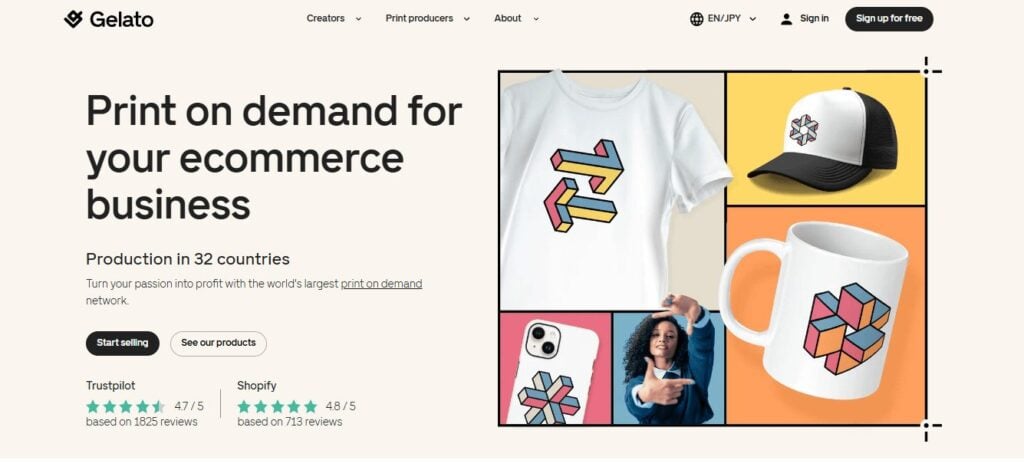 Gelato revolutionises the print on demand (POD) industry with its global network of local printers, enabling artists to fulfil orders quickly and sustainably. By leveraging local printing facilities in over 30 countries, Gelato minimises shipping distances and reduces carbon emissions, making it an environmentally friendly choice for artists committed to sustainability.
Gelato revolutionises the print on demand (POD) industry with its global network of local printers, enabling artists to fulfil orders quickly and sustainably. By leveraging local printing facilities in over 30 countries, Gelato minimises shipping distances and reduces carbon emissions, making it an environmentally friendly choice for artists committed to sustainability.
Artists appreciate Gelato’s commitment to quality, as each product undergoes rigorous quality control measures to ensure consistent printing standards. Gelato’s platform integrates seamlessly with e-commerce stores, offering artists a streamlined experience from design upload to order fulfilment. With competitive pricing and efficient logistics, Gelato empowers artists to expand their global reach while maintaining high standards of print quality and environmental responsibility.
JetPrint
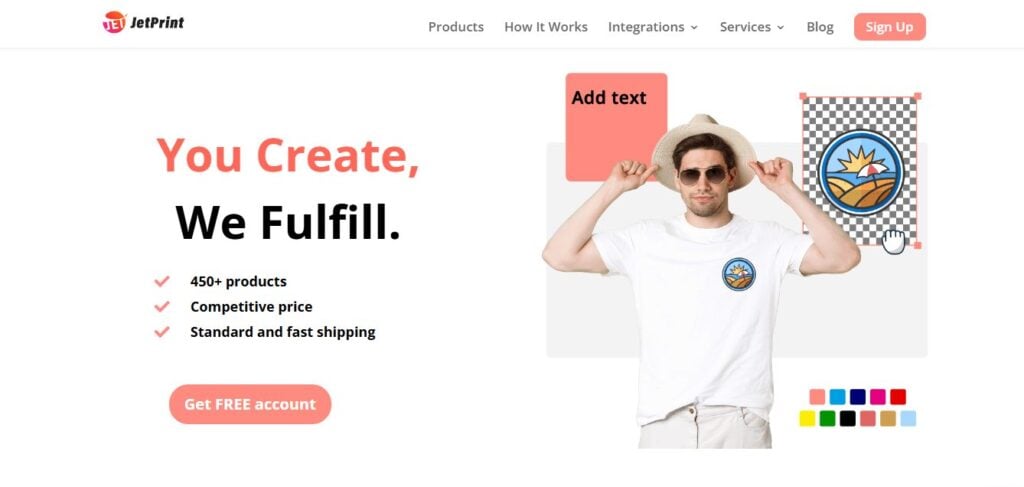 Known for its rapid turnaround times and cost-effective pricing structure, JetPrint appeals to artists aiming to optimise their profit margins without compromising on product quality. JetPrint’s intuitive dashboard allows artists to upload designs seamlessly and customise products to meet their creative vision.
Known for its rapid turnaround times and cost-effective pricing structure, JetPrint appeals to artists aiming to optimise their profit margins without compromising on product quality. JetPrint’s intuitive dashboard allows artists to upload designs seamlessly and customise products to meet their creative vision.
Artists value JetPrint’s responsive customer service and reliable shipping options, ensuring that orders are processed swiftly and delivered on time. The platform’s competitive pricing and bulk order discounts further incentivise artists to scale their businesses efficiently while maintaining high standards of print quality and customer satisfaction.
Modalyst
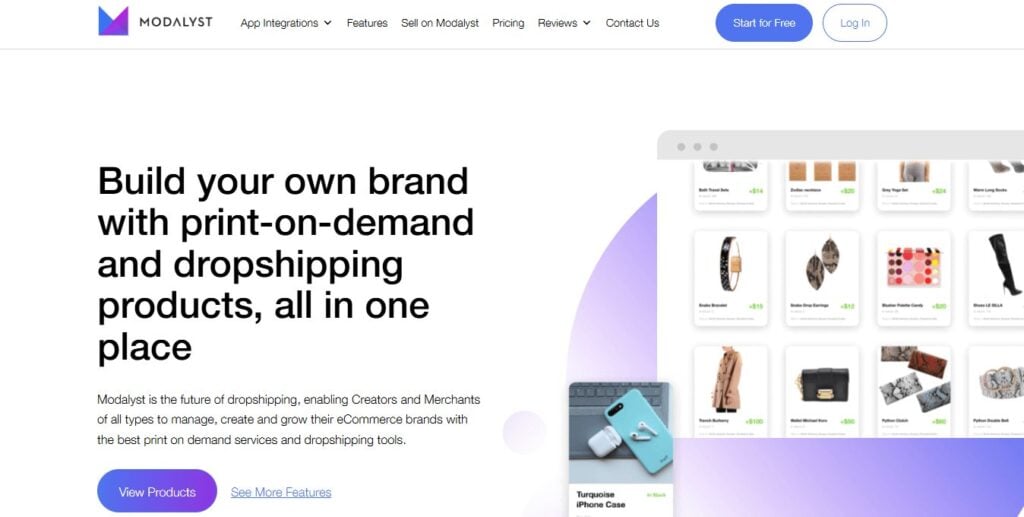 Modalyst is a versatile platform catering to artists interested in dropshipping, offering a wide selection of products sourced from verified suppliers worldwide. Artists benefit from Modalyst’s extensive supplier network, which provides access to on-demand production and direct shipping options.
Modalyst is a versatile platform catering to artists interested in dropshipping, offering a wide selection of products sourced from verified suppliers worldwide. Artists benefit from Modalyst’s extensive supplier network, which provides access to on-demand production and direct shipping options.
Modalyst simplifies the process of launching an online store by automating inventory management and order fulfilment. Artists can choose from a variety of products, from apparel to accessories, and customise them to reflect their unique artistic style. With competitive pricing and flexible shipping options, Modalyst supports artists in scaling their businesses efficiently while focusing on creative innovation and customer satisfaction.
Zazzle
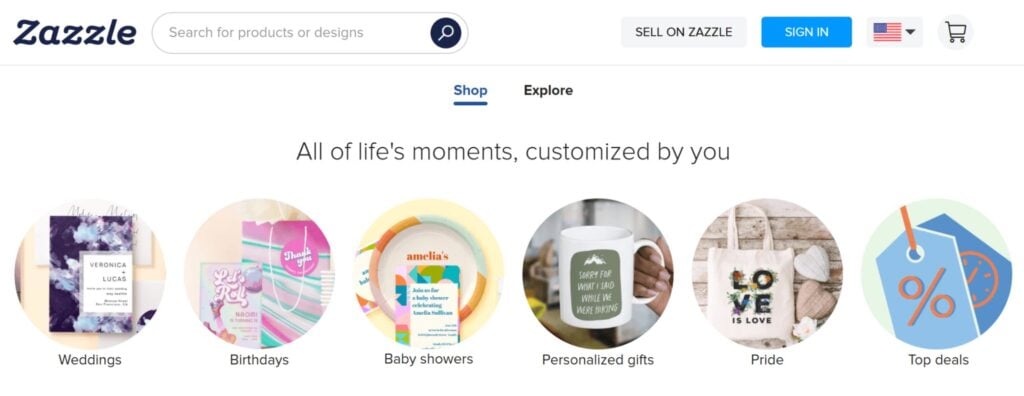 Zazzle stands out for its expansive marketplace and robust customisation tools, empowering artists to create unique designs across a diverse range of products. Artists appreciate Zazzle’s comprehensive design interface, which allows for easy customisation of merchandise from specialty gifts to office supplies.
Zazzle stands out for its expansive marketplace and robust customisation tools, empowering artists to create unique designs across a diverse range of products. Artists appreciate Zazzle’s comprehensive design interface, which allows for easy customisation of merchandise from specialty gifts to office supplies.
The platform’s integrated marketplace enables artists to reach a global audience of buyers seeking personalised and custom-designed products. Zazzle’s print-on-demand services ensure that each item is produced to the highest standards, maintaining the integrity of artists’ original designs while offering customers a wide selection of customisable options.
Redbubble
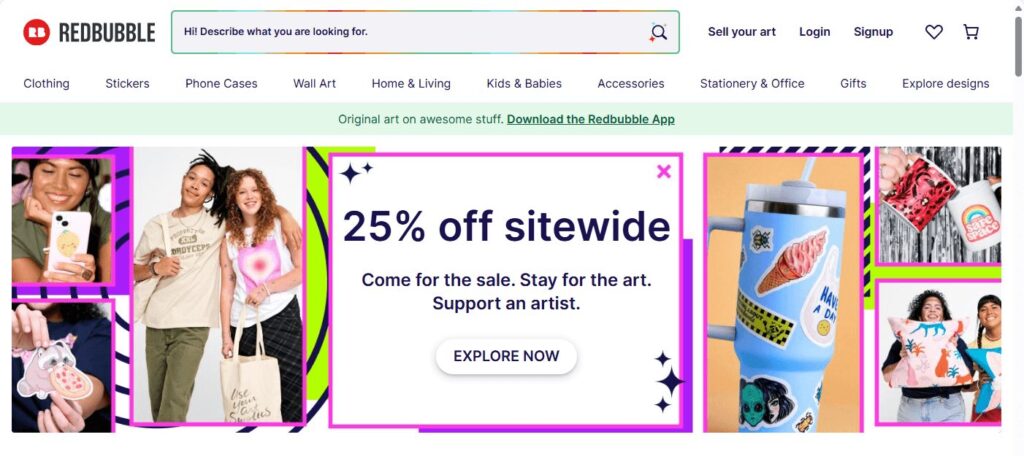 Redbubble stands out for its vibrant artist community and extensive range of products, making it a popular choice among artists seeking to showcase and sell their artwork globally. Artists can upload their designs to Redbubble’s platform, which offers a wide array of products including stickers, phone cases, home decor, and more.
Redbubble stands out for its vibrant artist community and extensive range of products, making it a popular choice among artists seeking to showcase and sell their artwork globally. Artists can upload their designs to Redbubble’s platform, which offers a wide array of products including stickers, phone cases, home decor, and more.
The platform’s global shipping capabilities ensure that artists can reach a diverse international audience, expanding their visibility and sales opportunities. With a strong focus on artist empowerment and creative expression, Redbubble continues to be a preferred platform for artists looking to monetise their artwork effectively.
Gooten
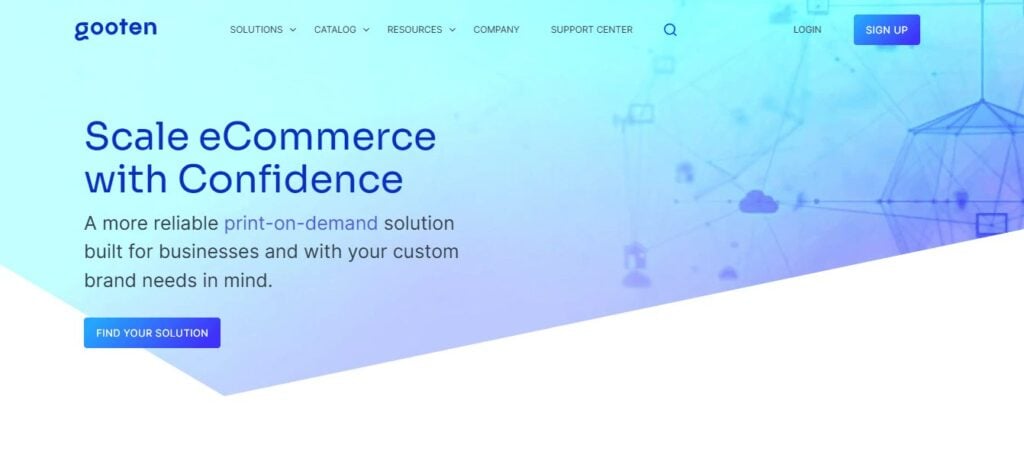 Gooten specialises in print on demand services that prioritise customisation and scalability for artists and entrepreneurs alike. Artists can choose from a variety of products ranging from apparel to home goods, each customisable with unique designs.
Gooten specialises in print on demand services that prioritise customisation and scalability for artists and entrepreneurs alike. Artists can choose from a variety of products ranging from apparel to home goods, each customisable with unique designs.
Gooten’s streamlined order management system and integration with leading e-commerce platforms simplify the selling process for artists, allowing them to focus on creativity rather than logistics. The platform’s competitive pricing and high-quality printing ensure that each product meets artist standards and customer expectations. With reliable fulfilment services and a commitment to innovation, Gooten remains a trusted partner for artists navigating the print on demand landscape.
Society6
 Overview:
Overview:
Society6 stands out as a unique marketplace for artists and designers seeking a platform to sell distinctive and creative products. It caters to a niche audience that appreciates originality and artistry. The platform allows artists to upload their designs and sell them on a range of products, from art prints to home decor, offering a broad canvas for creative expression.
Unique Advantages:
- Diverse Product Range: Society6 offers an extensive variety of products, allowing artists to showcase their work in numerous formats.
- Artistic Community: It fosters a vibrant community of artists, providing a supportive environment for creativity and collaboration.
- Artist-Centric Model: Artists retain control over the rights to their work and gain exposure to a global audience.
- Earnings Model: Society6 operates on a profit-sharing model, where artists earn a commission on each sale.
Considerations:
- Market Saturation: Due to the popularity of the platform, artists may face stiff competition, necessitating strong marketing and branding efforts.
- Limited Customisation: While offering a range of products, the customisation options for each item might be limited compared to other POD services.
Amazon Merch on Demand
Overview:
Amazon Merch on Demand offers seamless integration with Amazon, giving artists access to a vast audience. The platform simplifies the process from design upload to product management, backed by Prime Shipping and a no-inventory-risk model.
Unique Advantages:
- Direct Amazon integration
- No upfront costs
- Prime Shipping eligibility
- Royalty-based earnings
- Insightful analytics tools
Considerations:
- Artists might need to focus on creative aspects over business management
Evaluating and Starting a Print-on-Demand Business
In the dynamic and ever-evolving landscape of print-on-demand (POD) services, making an informed decision requires a methodical and multifaceted approach. This guide employs a comprehensive methodology that delves deeply into various critical aspects that define the efficacy and suitability of a POD service. By meticulously analysing each factor, this approach aims to provide a detailed, nuanced understanding, thereby empowering you to make decisions that align closely with your business objectives and operational preferences in the POD industry.
Research and Define Your Niche
Start by conducting thorough market research to identify a profitable niche for your POD products. Consider your interests, expertise, and the needs of your target audience. Look for underserved or trending markets where your unique designs can make a significant impact. A deep understanding of your niche will help you create products that resonate with your target audience and stand out in a competitive market.
Choose a Reliable Print-on-Demand Platform
Choosing the right POD platform is crucial to the success of your business. Evaluate platforms based on factors such as product variety, print quality, pricing, and customer support. Platforms like Printful and Printify are known for their extensive product range and seamless integration with e-commerce platforms like Shopify and WooCommerce, simplifying the setup and management of your online store.
Make sure the platform offers robust features for uploading designs, customising products, and efficiently handling order fulfilment. Consider the following factors when choosing a POD service:
- Product Quality Assessment: Ensure the platform adheres to industry standards, uses cutting-edge technology, and provides consistent quality across different orders and batches. Customer feedback can provide real-world insights into product satisfaction.
- Custom Branding: Look for services that allow for custom branding on packaging, labels, and invoices to maintain a cohesive brand image.
- Global Shipping: Evaluate the platform’s shipping reach, reliability, cost-effectiveness, and delivery speed, as these factors can significantly affect your pricing and customer satisfaction.
Create High-Quality Designs
Focus on creating designs that are unique, trend-setting, or niche-specific to differentiate your products in the market. Pay attention to colour schemes, typography, and design elements that align with current trends and customer preferences. Consistency and quality across all your designs are essential for building brand credibility and customer trust.
Launch and Promote Your Products
Launch your POD business with a strong marketing strategy to generate initial buzz and attract customers. Utilise social media advertising, email marketing campaigns, influencer partnerships, and promotional offers to create excitement around your products. Leverage customer reviews and testimonials to build credibility and encourage trust among potential buyers. Monitor sales performance and customer feedback to iterate and improve your product offerings continuously.
Financial Viability of POD Services
Financial considerations are paramount in evaluating POD services. This includes a detailed analysis of the fee structures and commission rates, which are crucial for understanding the cost implications for businesses. Assessing potential profit margins is important for determining the financial viability of using the service. It’s also vital to identify any hidden costs or financial pitfalls that might be associated with the service to ensure there are no unexpected expenses down the line.
Customer Reviews and Ratings
Genuine customer reviews and ratings are invaluable for assessing POD services. They offer a spectrum of user experiences, providing a realistic picture of the service’s strengths and weaknesses. Identifying common patterns in customer feedback can also highlight systemic issues or areas where the service excels.
Conclusion
The landscape of print-on-demand platforms for artists offers a diverse array of options, each with unique strengths and advantages. From platforms like Printful and Printify, known for their extensive product range and seamless integration, to niche-focused providers such as Zazzle and Gooten, artists have abundant choices to showcase their creativity and reach a global audience.
Whether you prioritise eco-consciousness with platforms like PrintKK or seek rapid fulfilment through services like JetPrint, these platforms cater to various needs and preferences. By choosing the right platform that matches your business goals and artistic vision, you can successfully start your print-on-demand journey.
FAQs
- Is print-on-demand suitable for beginners? Absolutely! It requires minimal upfront investment, allows you to start small, and offers the flexibility to test various designs and products without holding inventory.
- Is it profitable to print on demand? Yes, print-on-demand can be highly profitable. By eliminating upfront costs and inventory risks, you can focus on creating and marketing unique designs.
- What are the trends in print on demand? Current trends in print-on-demand include personalised products, eco-friendly materials, and seamless integration with e-commerce platforms.
- Where can I sell my print-on-demand merchandise? You can sell your print-on-demand merchandise on popular e-commerce platforms like Shopify, Etsy, and Amazon. These platforms provide a ready-made audience and robust tools for marketing and selling your unique designs worldwide.
By carefully considering these detailed factors, you can select a print-on-demand company that not only aligns with your business objectives but also supports and enhances your brand’s growth in the competitive online marketplace.










